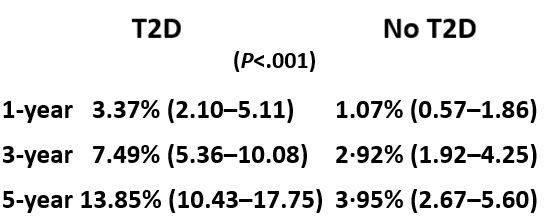In Patients with NAFLD, Type 2 Diabetes Significantly Ups Risk for Hepatic Decompensation, Hepatocellular Carcinoma
In patients with NAFLD, type 2 diabetes was found to be an independent predictor of both hepatic decompensation and incident HCC, according to meta-analysis authors. .
©Kateryna_Kon/Adobe Stock

In individuals with nonalcoholic fatty liver disease (NAFLD) and type 2 diabetes (T2D), the risk of hepatic decompensation and hepatocellular carcinoma (HCC) at 5 years was more than 3-fold greater than among those without T2D, according to new data from an international meta-analysis.
After adjustment for confounding variables, study investigators found that T2D was an independent predictor of both hepatic decompensation and incident HCC.
The research team, led by Daniel Q Huang, MBBS, of the NAFLD Research Center and the division of gastroenterology and hepatology at the University of California San Diego, also found that elevated HbA1c was associated with hepatic decompensation.
NAFLD, including nonalcoholic steatohepatitis (NASH), is the most common form of liver disease in individuals with T2D, with more than 1 in 3 affected by NASH and 1 in 6 by advanced liver fibrosis, according to the authors.
“Previous studies have shown that type 2 diabetes is associated with hepatic decompensation among people with cirrhosis, hepatitis C virus, and heavy alcohol consumption,” investigators wrote in the Lancet Gastroenterology and Hepatology. “However, the risk of hepatic decompensation (development of ascites, hepatic encephalopathy, or variceal bleeding) among individuals with NAFLD with and without type 2 diabetes has not been systematically assessed.”
Their meta-analysis comprised individual participant level data from 6 international cohorts whose participants had magnetic resonance elastography (MRE) between February 27, 2007, and June 4, 2021. In addition to liver fibrosis identified by MRE, eligible studies included longitudinal assessment for hepatic decompensation and death and participants were adults aged ≥18 years with NAFLD who had data supporting a diagnosis of T2D at baseline.
For the primary outcome, Huang et al were interested in hepatic decompensation, defined for the study as ascites, hepatic encephalopathy, or variceal bleeding. The secondary outcome was incident HCC. Competing risk regression using a subdistribution hazard ratio (sHR) was used to compare the likelihood of hepatic outcomes in patients with and without T2D.
FINDINGS
The initial cohort numbered 2016; 53.5% were women, mean age was 57.8 years, and mean body mass index was 31.3 kg/m2. After excluding participants who had hepatic decompensation at baseline and those without longitudinal data, there were 1737 participants in the group for final analysis, of whom 602 had T2D at baseline.
Hepatic decompensation. Over a median follow-up of 2.8 years, 105 participants (11.8%) developed hepatic decompensation or died without hepatic decompensation. The risk of hepatic decompensation (sHR, 95% CI) was significantly higher among participants with T2D vs no T2D at 1, 3, and 5 years:

After adjustment for patient age, BMI, and race/ethnicity, Huang and colleagues found that both T2D (sHR, 2.15; 95% CI, 1.39 – 3.34; P=.006) and HbA1c (sHR, 1.31; 95% CI, 1.10 – 1.55; P=.002) were independent predictors of hepatic decompensation when investigators adjusted for patient age, BMI, and race/ethnicity.
Hepatocellular carcinoma. The analysis for HCC included 1802 participants 639 with (T2D). Over a median follow-up of 2.9 years, 22 participants (18 with baseline T2D, 4 without), developed incident HCC. Similar to the risk of hepatic decompensation, risk of incident HCC at 1, 3, and 5 years was significantly greater among participants with T2D vs without T2D (P<.001):
1 year 1.34 (95% CI, 0.64 – 2.54) vs 0.09 (95% CI, 0.01 – 0.50)
3 years 2.44 (95% CI, 1.36 – 4.05) vs 0.21 (95% CI, 0.04 – 0.73)
5 years 3.68 (95% CI, 2.18 – 5.77) vs 0.44 (95% CI, 0.11 – 1.33)
In adjusted analyses, T2D remained an independent predictor of HCC development, associated with a more than 5-fold risk (sHR, 5.34; 95% CI, 1.67 – 17.09; P=.0048) in patients with NAFLD.
Among the limitations the authors cite are the potential bias associated with retrospective analyses, the potential for the effects of unmeasured confounders, and the collection of data at tertiary centers, which may have introduced selection bias for participants at high risk.
“The higher risk of hepatic decompensation and HCC in people with type 2 diabetes should be considered when designing clinical trials in NAFLD,” investigators concluded. “These data serve as a call to action to prevent type 2 diabetes and reduce the growing burden of NAFLD and NAFLD-related hepatocellular carcinoma.”
Reference. Huang DQ, Noureddin N, Ajmera V, et al. Type 2 diabetes, hepatic decompensation, and hepatocellular carcinoma in patients with non-alcoholic fatty liver disease: an individual participant-level data meta-analysis. Lancet Gastroenterol Hepatol. 2023;S2468-1253(23)00157-7. doi:10.1016/S2468-1253(23)00157-7